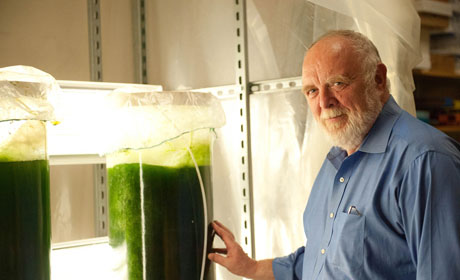| Jul 19, 2012 |
Study determines theoretical energy benefits and potential of algae fuels
|
|
(Nanowerk News) It's theoretically possible to produce about 500 times as much energy from algae fuels as is needed to grow the fuels, according to a new study by researchers at The University of Texas at Austin.
|
|
However, limited by existing technology, the researchers found in a separate study that their algae growing facility is getting out about one-five hundredth as much energy as it currently puts in to grow the fuels.
|
|
Robert Hebner, director of the university's Center for Electromechanics (CEM), conducts research in a large algae growth demonstration facility for biofuels. The facility is located adjacent to CEM.
|
|
"The search for cost-effective biofuels is one of the noble endeavors of our time, and these papers shed insight on where the boundaries are in algae research," said Robert Hebner, a professor in the Cockrell School of Engineering and director of the Center for Electromechanics. "One of the responsibilities of a top research university is to discover and explain what the boundaries are so we can innovate within those boundaries or create ways to expand them."
|
|
The findings were announced in three new studies published in June and co-authored by Hebner, Cockrell School Assistant Professor Michael Webber and researcher Colin Beal.
|
 |
| Robert Hebner, director of the university's Center for Electromechanics (CEM), conducts research in a large algae growth demonstration facility for biofuels. The facility is located adjacent to CEM.
|
|
The studies add important context to the viability of algae, which shows promise for producing large amounts of energy-dense fuel because it can be harvested nearly continuously all year. Algae can also be used for fertilizers, food, pharmaceuticals and more, but researchers must first figure out how to mass-produce the green source inexpensively.
|
|
Numerous studies have focused on the energy efficiency of algae, but limited comprehensive data is available. Present studies consider the cost, water intensity and resource constraints faced by algal biofuel production, in addition to the energy efficiency.
|
|
"These results are critical in the public policy domain," Webber said. "As we try to balance the use of energy and water for our future, it is important to base our decisions on what technology will permit us to do and at what cost. Otherwise we risk serious negative impacts on our quality of life. This work is an important contribution to the needed discussion."
|
|
Building on earlier work, the university researchers developed a theoretical understanding of the limits for the energy returned for the energy invested in algae growth. The theoretical limits were quite positive but require technology significantly ahead of current practice.
|
|
"We expect this comprehensive work will help provide a focus for current and future work. If progress is to be made, we need to have a clear understanding of the constraints we are facing, and how it might be possible for algae to contribute to our energy demands," Beal said.
|
|
The research team also studied the university’s algae growth facility at the J.J. Pickle Research Campus to identify all of the energy inputs to a real process, such as using electricity to run algae pumps and energy for chemical processing and water transport. Using this information and working with the City of Austin, they showed that combining algae growth with a sewage treatment facility is one approach to getting a positive energy return with existing technology. Algae get nutrients from phosphorus and nitrogen — chemical elements that are abundant in water treatment plants and must be removed from wastewater during treatment processing.
|
|
By combining the two processes, the system produced 1 ½ times more energy than was needed to grow algae.
|
|
Today, gas and oil produce 30 to 40 times more energy than is needed to get the fuels out of the ground.
|
|
"But it's getting harder and harder to get fossil fuels out of the ground," Hebner said. "With algae, the theoretical maximum is extremely positive."
|
|
With more than 3,000 specimens, The University of Texas at Austin is home to the largest and most diverse algae collection in the world. Last fall the Austin startup AlgEternal Technologies augmented the university's algae program by installing a growth demonstration facility on the campus. The university program provides public and private research partners access to facilities for analyzing, growing, harvesting and processing algae.
|
|
A second company, OpenAlgae, is developing algae-specific processing technologies with the university to enhance the economics of oil production from algae. OpenAlgae provided partial funding for the studies, which will appear in the journals Energies, Energy and Water Environment Research.
|

